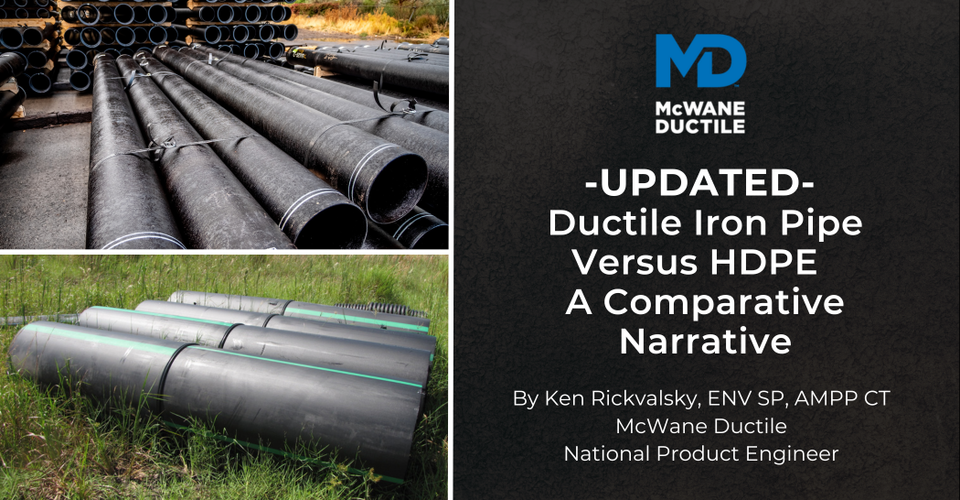-
Six Common Ductile Iron Pipe Questions Answered
07/15/2022 In Installation ProductsThrough the years, across the country, contractors, engineers, authorities, and customers routinely ask questions that seem basic yet truly speak to the fundamental versatility of Ductile iron pipe (DI pipe). Among the most popular questions are:
-
Customer Spotlight: Legacy Water Group
07/08/2022 In Installation Project ProfileEven at the height of summer construction, casting pipe, and filling orders for more pipe, there's always time to take a moment to spotlight some of the great partnerships McWane Ductile has developed over the years. Once such partnership is that with Legacy Water Group who recently completed a water pipeline project in Athens, Alabama. This #IronStrong Blog quickly describes some of the highlights from the project.
-
When and Why Would I Use a Mechanical Joint Lock Joint to Restrain Ductile Iron Pipe?
06/30/2022 In Our Company Products TechnicalWhen it comes to restraining a water line, what comes to mind? Thrust blocks? Sure Stop 350® Gaskets? (locking gasket), TufGrip™ (wedge-action retainer gland), or maybe the standard default choice, TR Flex®? (Ductile iron restrained joint pipe). There is another option that might not regularly come to mind. It is known as Mechanical Joint Lock Joint or MJLJ for short. We will look at how the joint works, how it is installed, and locations where the MJLJ may be preferred.
-
National Skilled Trades Day – Appreciation of Those Building Iron Strong Pipelines
05/04/2022 In Our Company TechnicalWhat is National Skilled Trades Day, and what is its importance? National Skilled Trades Day is celebrated on the first Wednesday in May. City Machine Technologies, Inc. founded National Skilled Trades Day to bring awareness to the skilled trades shortage facing the United States. The day also celebrates those who work in the trades, shedding a positive light and celebrating the importance of skilled trades jobs. Many highly skilled workers fill a multitude of careers across our nation, including construction, healthcare, manufacturing, and service industries.
-
How to Calculate Polyethylene Tape Requirements for Ductile Iron Pipe
04/29/2022 In Installation Products TechnicalIn my career with McWane Ductile, I've sold my fair share of polywrap, but the one thing that I haven't really thought about when selling polywrap is the tape needed to complete the installation. I'm not sure why this is. Maybe the biggest reason is I wasn't sure how much tape was required for each roll of polywrap I sold. Therefore, I wanted to take a deep dive into this subject to make it easier for people to know when ordering polywrap how much tape they need to purchase as well.
-
How Multiple Events Collided to Affect Ductile Iron Pipe Supply
04/21/2022 In Our Company ProductsLike many other industries, no one could have predicted the multitude of unrelated events that conspired to cause supply chain issues worldwide. But one thing is for certain in the water and wastewater pipe sector, we have experienced one challenge after another.
-
What Does Diversity Look Like in the Manufacturing Industry?
03/08/2022 In Our CompanyOver the years, manufacturing companies have not made as much progress with diversity and inclusion – specifically in recruiting women – like other sectors, but by working together and sharing best practices, we can become more effective in this initiative.
-
Ask the Ditch Doctor - Does Internal Pressure Always Govern Ductile Iron Pipeline Design?
03/04/2022 In Ditch Doctor Installation TechnicalHave you ever been so taken aback by the structure of a question that your first thought is, “say what? Did they really just ask me that?” In the vernacular-sensitive world of utility pipelines, it happens more often than you might think.
-
How Do Engineers Impact the Waterworks Industry?
02/26/2022 In Our Company ProductsIt’s National Engineers Week (EWeek). Founded by the National Society of Professional Engineers in 1951, (EWeek) is dedicated to promoting careers in engineering and technology to develop a diverse and well-educated future engineering workforce. This #IronStrong Blog spotlights the importance of engineers and how they impact the waterworks industry.
-
Why Doesn’t McWane Ductile Make Large Diameter Locking Gaskets?
02/11/2022 In Products TechnicalLocking gaskets are the industry standard for dependable, reliable, and easy installation of Ductile iron pipe (DI pipe) in 3-inch through 24-inch diameters. Locking gaskets for DI pipe have been around for more than 30 years and have been used in over one million push joint installations. However, as good as locking gaskets are in 3-inch through 24-inch, there were challenges involved when attempting to install in 30-inch and 36-inch diameter pipe. In this Iron Strong Blog, we will look at the various reason we do not make large-diameter locking gaskets for DI pipe.
Latest Posts
- Can Joining Water Works Industry Organizations Help You Grow Professionally? 10/21/2025 In Careers WaterWorks
- How Does Ductile Iron Pipe Provide Proven Resilience to Seismic Events? 09/04/2025 In Products Resiliency Technical
- How to Secure Green Reserve Sustainability Incentives Using State Revolving Funding & Ductile Iron Pipe 07/29/2025 In Energy Products Technical
- UPDATED - Ductile Iron Pipe Versus HDPE - A Comparative Narrative 05/29/2025 In Comparisons Products Technical















